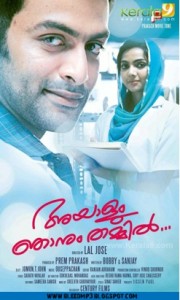With the recent controversy surrounding Arabi Kalayanam (the term used to describe the practice of marrying young girls from Kerala, India to Arab men for a lesser dowry), and legalizing marriage for Muslim girls younger than 18 years of age, I was reminded of T.V Chandran’s 2003 movie, Padam Onnu Oru Vilapam (Chapter One: A Wail). It is probably the only Malayalam movie which dives deeply into the multiple social evils that are still prevalent among Muslims in the Malabar community of Kerala.

Padam Onnu Oru Vilapam choses to showcase the state of women, from the lower/working class of the Muslim society, and focuses on issues such as forced marriages of minors, polygamy among Muslim men, marital rape and Arabi Kalyanam. A 2012, movie which won the Kerala state award, Ayalum Njanum Thammil, (Between Him and Me) also has a Muslim girl , Sainu, as the main female protagonist. Ayalum Njanum Thammil discusses various relevant issues, ike bribery in hospitals andcorrupted doctors, but within the context of another part of the Muslim community, which is financially stable, and under no monetary pressurewhen it comes to marrying off their daughters. Yet both characters, one from a middle class family and the other from an economically deprived background suffer a similar fate.
Shahina, in Padam Onnu Oru Vilapam is a 14 year old school girl preparing for her class Xth exam when some local imams nd her uncle force her into marriage as a man’s second wife. Shahina is too young to understand sex, and is scared of it. She shrieks, screams and runs away from her husband on their first night much to his dismay and embarrassment. While the husband tries multiple times to consummate the marriage, it all ends in failure. Shahina doesn’t let his first wife sleep with him either. Finally the husband drugs her and rapes her. Shahina responds violently after waking up. She is divorced on grounds of being mentally ill, right after, with the triple talak. She happily returns home and while writing her exam collapses, and is later found to be pregnant. She is ostracized in society and accused of adultery as her husband claims to have never touched her. She joins the long line of hapless women who are deserted after such marriages, left with young children to feed.

In sharp contrast to her own life, Shahina’s close Hindu friend, Janakikutty, continues her education and goes to college to pursue higher studies. Shahina tells her mother that she wants to be just like Janakikutty someday.
Ayalum Njanum Thammil (Between Him and Me) depicts another side of the story, that of Muslim girls who come from a better financial background, with well to do families, who are allowed to complete their education and probably have been given the same freedom and choice as their male siblings. Sainu is a medicine student, who is the love interest of the Christian protagonist. After a failed elopement attempt, she agrees to the marriage arranged by her parents, and is torn away from her boyfriend who lives the rest of his life with a broken heart.
It reminded me of my numerous cousins, relatives and other Muslim friends who had to undergo the same treatment. Let go or sacrifice their love under the pressure of their families and in the name of religion. It is of course not a phenomenon that exists just within Muslim societies, but Muslims are still lagging behind heavily in accepting an inter-religious marriage. The various hurdles faced in India for a couple from different religions to marry was discussed in this MMW article. As with the case of Shahina, we see that Sainu’s Hindu/Christian friends get married to each other with minimal parental opposition.

Between Sainu and Shahina, Shahina’s story can be argued to be the sadder one. She is only 14, and is left with no formal education to support herself. She is a victim of a social evil, she is illegally married. However even Sainu’s medical degree renders her helpless and she too, is forced into a marriage against her will, in the name of religion. Both movies compare the lives of young Muslim girls with that of their closest non-Muslim friends, who evidently has more freedom of choice and lesser societal restrictions – although in real life, not all non-Muslim girls/women are as freed from the shackles of society as is portrayed in both movies.
Here’s hoping that these touching portrayals go beyond winning accolades for the director and actors, and have a lasting impact on the parts of Muslim societies who see their daughters not as human beings with a right to their own life but rather a burden or a stalwart of their family honor.











